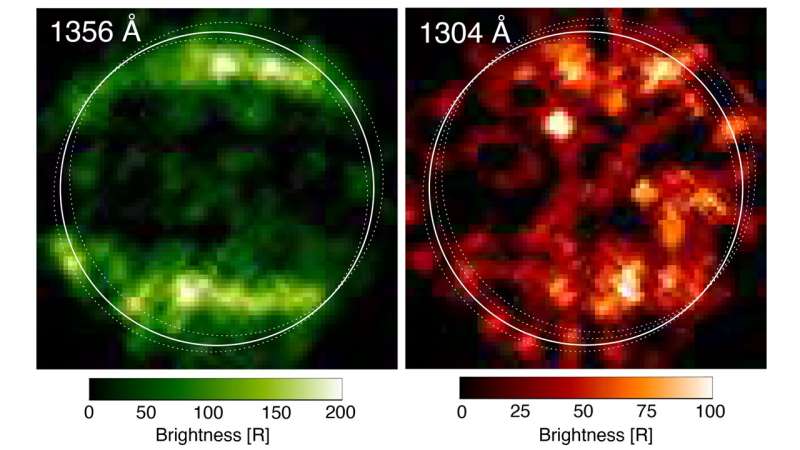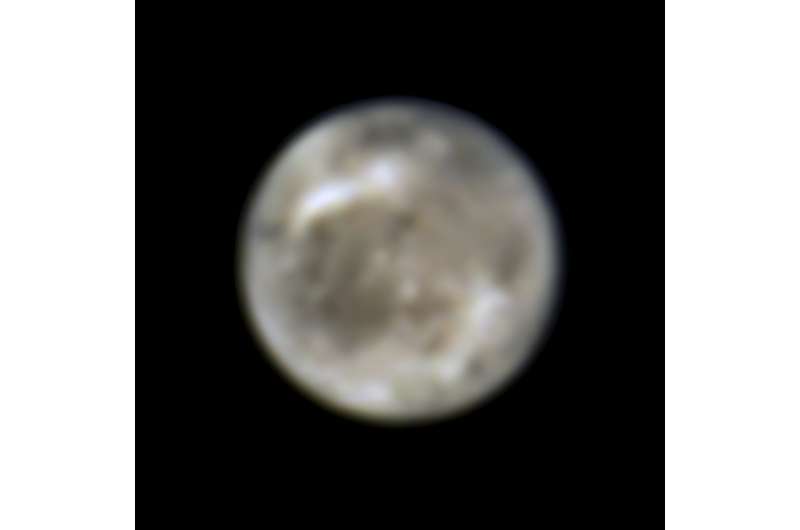Hubble finds first evidence of water vapor on Jupiter's moon Ganymede

For the first time, astronomers have uncovered evidence of water vapor in the atmosphere of Jupiter's moon Ganymede. This water vapor forms when ice from the moon's surface sublimates—that is, turns from solid to gas.
Scientists used new and archival datasets from NASA's Hubble Space Telescope to make the discovery, published in the journal Nature Astronomy.
Previous research has offered circumstantial evidence that Ganymede, the largest moon in the solar system, contains more water than all of Earth's oceans. However, temperatures there are so cold that water on the surface is frozen solid. Ganymede's ocean would reside roughly 100 miles below the crust; therefore, the water vapor would not represent the evaporation of this ocean.
Astronomers re-examined Hubble observations from the last two decades to find this evidence of water vapor.
In 1998, Hubble's Space Telescope Imaging Spectrograph (STIS) took the first ultraviolet (UV) images of Ganymede, which revealed in two images colorful ribbons of electrified gas called auroral bands, and provided further evidence that Ganymede has a weak magnetic field.
The similarities in these UV observations were explained by the presence of molecular oxygen (O2). But some observed features did not match the expected emissions from a pure O2 atmosphere. At the same time, scientists concluded this discrepancy was likely related to higher concentrations of atomic oxygen (O).
As part of a large observing program to support NASA's Juno mission in 2018, Lorenz Roth of the KTH Royal Institute of Technology in Stockholm, Sweden led the team that set out to measure the amount of atomic oxygen with Hubble. The team's analysis combined the data from two instruments: Hubble's Cosmic Origins Spectrograph (COS) in 2018 and archival images from the Space Telescope Imaging Spectrograph (STIS) from 1998 to 2010.

To their surprise, and contrary to the original interpretations of the data from 1998, they discovered there was hardly any atomic oxygen in Ganymede's atmosphere. This means there must be another explanation for the apparent differences in these UV aurora images.
Roth and his team then took a closer look at the relative distribution of the aurora in the UV images. Ganymede's surface temperature varies strongly throughout the day, and around noon near the equator it may become sufficiently warm that the ice surface releases (or sublimates) some small amounts of water molecules. In fact, the perceived differences in the UV images are directly correlated with where water would be expected in the moon's atmosphere.
"So far only the molecular oxygen had been observed," explained Roth. "This is produced when charged particles erode the ice surface. The water vapor that we measured now originates from ice sublimation caused by the thermal escape of water vapor from warm icy regions."
This finding adds anticipation to ESA (European Space Agency)'s upcoming mission, JUICE, which stands for JUpiter ICy moons Explorer. JUICE is the first large-class mission in ESA's Cosmic Vision 2015-2025 program. Planned for launch in 2022 and arrival at Jupiter in 2029, it will spend at least three years making detailed observations of Jupiter and three of its largest moons, with particular emphasis on Ganymede as a planetary body and potential habitat.
Ganymede was identified for detailed investigation because it provides a natural laboratory for analysis of the nature, evolution and potential habitability of icy worlds in general, the role it plays within the system of Galilean satellites, and its unique magnetic and plasma interactions with Jupiter and its environment.
"Our results can provide the JUICE instrument teams with valuable information that may be used to refine their observation plans to optimize the use of the spacecraft," added Roth.
Right now, NASA's Juno mission is taking a close look at Ganymede and recently released new imagery of the icy moon. Juno has been studying Jupiter and its environment, also known as the Jovian system, since 2016.
Understanding the Jovian system and unraveling its history, from its origin to the possible emergence of habitable environments, will provide us with a better understanding of how gas giant planets and their satellites form and evolve. In addition, new insights will hopefully be found on the habitability of Jupiter-like exoplanetary systems.
More information: Lorenz Roth et al, A sublimated water atmosphere on Ganymede detected from Hubble Space Telescope observations, Nature Astronomy (2021). DOI: 10.1038/s41550-021-01426-9
Journal information: Nature Astronomy
Provided by ESA/Hubble Information Centre




















